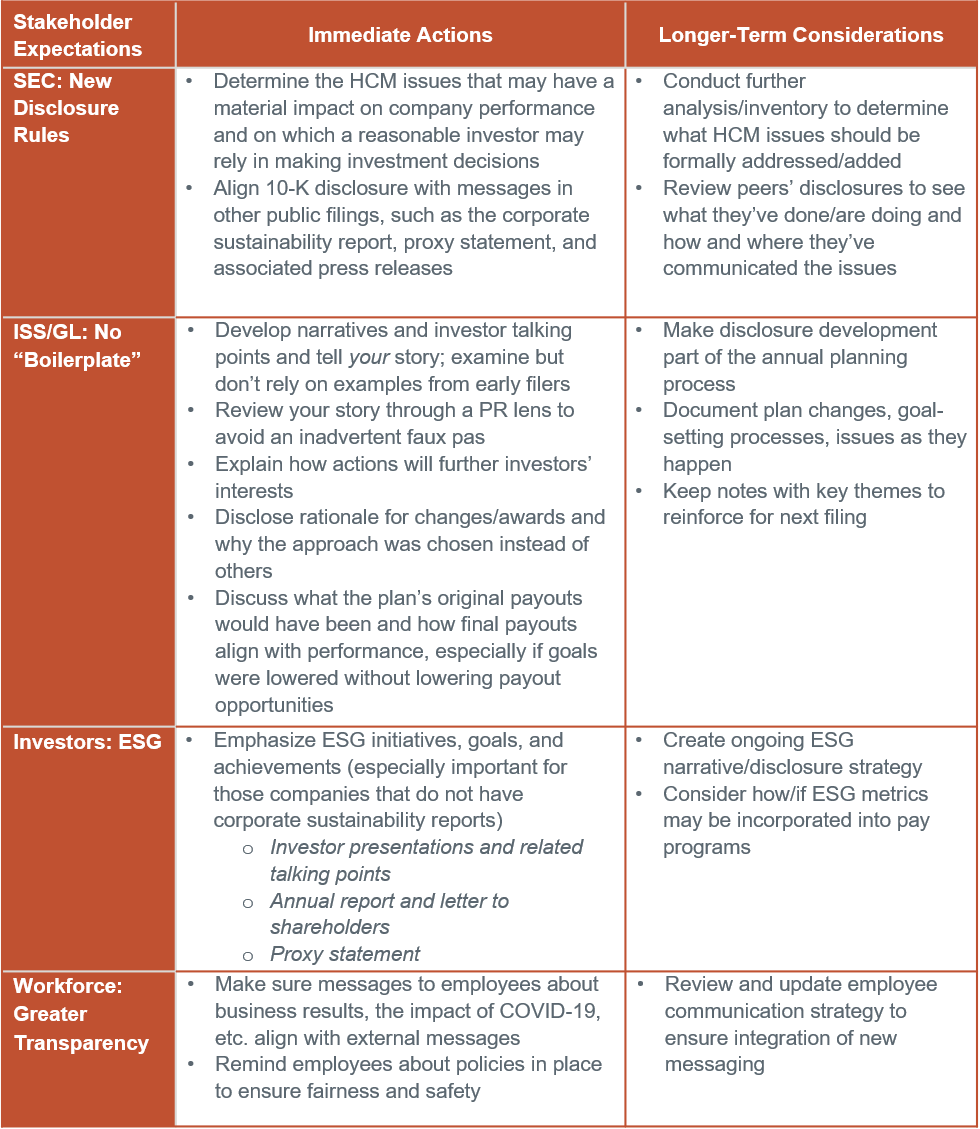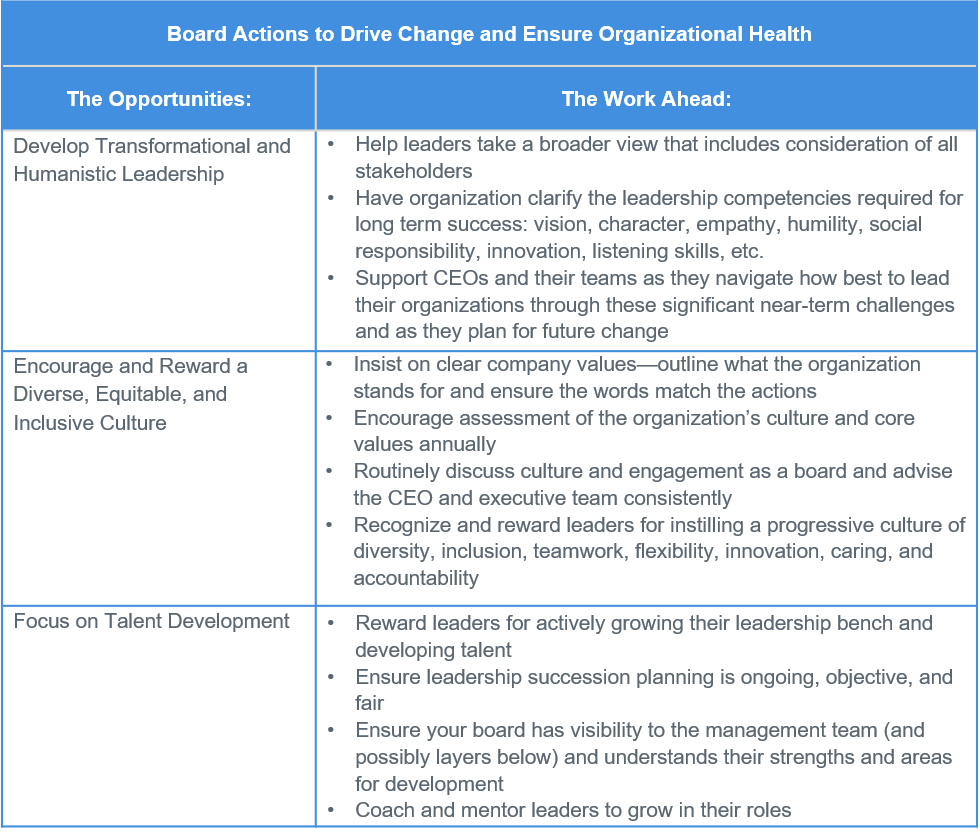
Article | Feb 2021
Five for the Future: Top Concerns for the Compensation Committee Agenda in 2021
The decisions made on each of these five important issues could have significant influence on public, private, and not-for-profit organizations for years to come.
Following a year like no other, compensation committees have kicked off 2021 facing many of the same questions they have been dealing with for months. Most companies can’t yet declare a turning of the page, and while vaccine availability and the beginnings of a rollout is very welcome news, it is still an unknown variable to add to the mix, along with new variants, unclear economic indicators, a new administration, and more.
This year, Pearl Meyer’s annual “Top Five” items for the compensation committee address the uncertainty many companies are facing, along with the human capital management topics that we believe should be top-of-mind as boards lead their companies through 2021. And these five issues are not bound to 2021 alone. How compensation committees weigh their positions on each of these concerns and the decisions they ultimately make—particularly if those decisions are brave and bold—stand to have great influence on the organizations they serve for years to come.
- Discretion: What lessons were learned from the use of discretion with respect to 2020 compensation arrangements, and is the continued use of discretion necessary and advisable for 2021 and beyond?
- Disclosure: How do you accurately and effectively disclose 2020 compensation decisions, as well as changes that are being made for 2021?
- Strategy Alignment: As business strategies change in response to the current environment, how do you assess and potentially change your compensation programs to ensure they are driving the desired behaviors, actions, and results?
- Goal-Setting: Given the considerable amount of uncertainty still present as we head into 2021, what strategies and approaches to goal-setting should be reviewed and considered in order to achieve the desired linkage between pay and performance?
- Organization Health: As companies pivot from survival to prosperity, how do you assess and strengthen your organization’s health in terms of culture, leadership, and talent, the core foundational elements for long-term success?
1. Key Principles for Discretion
Discretion is defined as “the freedom to decide what should be done in a particular situation.” While compensation committees always have the right to exercise discretion, the “particular situation” of 2020 and 2021 has almost mandated its usage for companies where performance has been materially impacted by COVID-19. And with all freedoms comes responsibility—the responsibility to act thoughtfully and appropriately given the facts and circumstances.
For compensation committees, one of the more challenging aspects of the pandemic has been how differently companies have been impacted. For example, airlines and restaurants were immediately and severely negatively impacted while essential retail and streaming services prospered. The other challenging aspects were limited real-time data for actions being taken by other companies, and boilerplate policies of proxy advisory firms that did not fit this particular situation. This dichotomy of impact and lack of external guidance further complicated the use of discretion.
What have we seen and learned thus far? The primary use of discretion has taken place with respect to 2020 bonus payouts. In many cases, the performance goals for these programs were set pre-pandemic and therefore had little or no relevance midway through the year. The severely negatively impacted companies have or will consider exercising discretion to fund or increase a level of bonus payout that they believe appropriately aligns pay and performance given the particular situation. The positively impacted companies have also been considering whether negative discretion should be used to lower bonus payouts to adjust for unexpected tailwinds that may not persist into 2021.
Another important learning is the linkage between decisions being made with respect to 2020 and 2021. Companies that aggressively used discretion for 2020 payouts may choose to be more conservative with any adjustments to 2021 incentive plan designs or payouts. Whereas companies that resisted or minimized the use of discretion in 2020 may choose to be more aggressive with respect to adjustments to 2021 incentive plan designs or payouts. This is indicative of the balance that many compensation committees have been seeking in their application of discretion.
In addition to balance, other principles have emerged that help provide a foundation for the exercise of discretion, such as:
- Believing that actions taken are in the best interests of shareholders;
- Ensuring that any outcomes retain a strong linkage between pay and performance; and
- Doing the right thing for the business even it might be criticized by third parties with imperfect information.
This grounding of discretionary actions with key principles is what can enable compensation committees to move forward with conviction during this “particular situation.”
2. A New Era for Disclosure
Traditional pay disclosure is officially a thing of the past—the SEC, proxy advisory firms, investors, and each organization’s workforce all expect much more. The desire for transparency on environmental, social, and governance (ESG) and human capital management (HCM) issues is almost insatiable. This, in addition to the continued pressure on boards to be crystal clear about their decisions around executive compensation, makes for a completely new set of communication challenges for directors to address in 2021 and into 2022. If we take a closer look at each of the key stakeholder groups vying for more information, we can breakdown some specifics:

With these higher expectations, there are immediate actions and longer-term considerations on disclosure and communication to address:

3. Revisiting Business Strategy and Alignment of Compensation
Quite simply, the pandemic gave rise to the largest global economic shock—and business transformation period—of our lifetimes. While some companies did benefit from the situation, the virus exposed material weaknesses in many companies in a rather painful way. Wholesale changes in how work gets done and how we communicate were accomplished by urgent necessity in a fraction of the time it would have otherwise been expected. These changes alone were nothing short of monumental, and we expect that many will become part of the fabric of how work is accomplished going forward.
As we begin 2021, companies are meeting with their boards to discuss lingering near-term issues, but also their business overall in a post-pandemic world. This is informed with fresh thinking on new areas of focus and new strategies. Just like “business as usual” was not acceptable in 2020, “compensation as usual” should not be acceptable in 2021. Customer needs have changed, workforce needs have changed, and people and compensation should be realigned with those new preferences. It is now incumbent on compensation committees, leadership teams, and HR professionals to ensure these new business directions and ideas are supported by meaningful links between people and compensation strategy and design. This begins with asking some significant new questions:
- What are the best metrics to drive our business priorities and goals?
- How do we create line of sight for employees given our changing business?
- What has COVID-19 taught us about the things our employees value?
- Do we have the right leaders in place to support our changing busines model or strategies?
- Has the virtual workforce opened up new opportunities for talent?
Based on recent work with clients, we have seen a number of changes occur as a result of these exercises. Certainly, many companies have re-evaluated the metrics in their incentive program to ensure continued alignment, some testing conventional wisdom on goal-setting and calibration with payouts. We have seen evidence of changes to long-term incentive mix not only to mute the lingering effect of COVID-19, but also to highlight changing attitudes regarding the primary objectives and attributes of long-term incentives. Some high profile companies have made public announcements regarding permanent work-from-home models and associated HR and compensation policy changes and others are sure to follow suit.
Ultimately, your company may come to different conclusions than the examples above. In fact, this would be a preferred outcome. Each company is inherently different and how they have responded to the recent stress and change is unique, thus individual compensation and people strategies must be different as well. Well thought-out differences in your pay programs relative to your competitors and in line with your evolving business strategy can create a tremendous competitive advantage—one that may be more important than ever.
4. A Tool-Kit for Setting Goals that Preserve Pay-for-Performance Alignment
Setting performance goals in “normal” circumstances is challenging enough. But this year the challenge is unusually acute and rife with new variables: a still uncertain economy, a remaining COVID-19 threat, a new administration, and an evolving model of corporate governance and leadership prodded on by social change—all of which are elevating the profile of measures beyond profit and growth.
In normal times companies with good goal-setting processes can rely on a multitude of analytic inputs, including historical company and peer performance, industry outlooks, the annual and long-range planning processes, and the modeling of shareholder expectations reflected in share prices. But for 2021, these inputs all seem less reliable. In the face of this situation, it can be helpful to remind ourselves what we are trying to do with respect to the incentive plans and the goals we set. Generally speaking, we want to:
- Continue to provide a fair and competitive incentive opportunity;
- Keep management focused on value creation and value preservation; and
- Continue to hold management accountable for overall firm performance, not merely or narrowly on controllable performance, which can be a slippery slope.
In other words, we want to maintain a balance—between incentive and retention, and between alignment with shareholders and line of sight to controllable performance. This year and beyond, companies may find it helpful to consider tools from four buckets to better align incentive goals with objectives.
The Measures
Some measures are more sensitive to external conditions than others. Some measures reflect non-operating results. Consider moving “upstream” on the income statement from earnings-per-share (EPS) or Net Income to NOPAT (net operating profit after tax), EBIT (earnings before interest and taxes), or EBITDA (earnings before interest, taxes depreciation, and amortization). Consider margins instead of total dollars. If your company’s results are particularly sensitive to an exogenous factor—like FX, interest rates, or a commodity input price—consider measuring results on a constant value basis, or place a collar around the value.
It may also be worthwhile to expand the measurement framework. More measures generally moderate results, with fewer extreme payouts below threshold or above maximum. Expanding the framework also makes room for measures beyond profit and growth—driver measures like customer satisfaction, employee engagement, sustainability, and culture measures in the ESG and DE&I categories.
The Performance Range/Scale
Broadening the performance range—from threshold to target, and from target to maximum—can also reduce extreme results. Consider that the slope need not be the same on either side of target. When reviewing business scenarios that vary from plan, recognize that sometimes there is more downside than upside, or vice versa.
Relative performance comparisons aren’t just for total shareholder return. There are practical considerations to relative comparisons with profit, growth, returns, and driver measures: Are there sufficient peers similar enough to the company for a fair comparison? Can we obtain data in a timely manner? Nevertheless, the challenges to forecasting and planning today may tip the scales in favor of relative comparisons.
Finally, related to holding an external factor constant, a company can set conditional goals that shift with changing external conditions.
The Performance Period
While three-year long-term plans have become nearly universal, there are times when planning for three years is just too difficult. Short of reverting to annual plans, a company can take a three-year average of performance. It can also measure cumulative results, as opposed to point-to-point growth or change. For annual plans, it might be worthwhile to split the year into halves in a year of acute uncertainty.
The Vehicle
Finally, consider the incentive vehicles being used. Many of the tools mentioned above could meet with criticism for reducing the performance linkage. However, when discussing long-term incentives, remember that using stock, or options, as the vehicle makes stock price a performance link. Proxy advisors do not like to see less than 50% of the LTI grant value delivered in “non-performance-based” vehicles. But when the market is more volatile and less certain than normal, it only makes sense to reconsider the balance. Also, increasing the share of LTI delivered in restricted stock can provide room to commit to more meaningful goals on the performance share unit program.
Keeping the objectives of the company’s incentive programs top of mind can help a company to set better, more robust goals. Consider all the tools available and apply them in ways that best match your company’s needs.
5. Cultivating Organizational Health
The beginning of this new decade demands a markedly different kind of leadership. We are beginning to see that out of the ashes of 2020, a new breed of leaders is emerging, exhibiting the kind of authentic leadership that reinvigorates, heals, and provides purpose. These leaders are promoting a culture of safety, inclusion, and diversity and by doing so, engendering a more committed and energized workforce. Extraordinary leaders and their teams are changing the face of the workplace and society at large and doing it with great speed and agility. They are creating sustainable business performance by taking care of people and the planet. For this, they need to be developed, recognized, and rewarded.
If boards are to make exceptional leadership a gold standard of practice, how can they guide current leaders and their teams on the path to transformation? The journey begins with selecting promising leaders who embody these practices and can model desired behaviors. Equally important in cultivating exceptional leadership is investing in existing leadership teams with constructive assessment, development, coaching, and mentorship, and then rewarding the right actions.

Boards and their management teams are focused now on managing through another year of great transition. They are dedicating considerable time to actions that yield healing and transformation. Through wrestling with a global pandemic, economic crisis, social injustice, and environmental climate shift—in addition to running a viable enterprise—they are by necessity transitioning a fragile and uncertain workforce to a new and better place. The most effective boards are helping their management teams prepare for this leadership journey with clear support and concrete actions. The expected return will be an innovative, creative workplace with renewed purpose, hope, and confidence—all of which can create greater individual health and wellbeing, along with organizational sustainability.
In Conclusion
The effects of 2020 may be felt for generations to come. It is still too early to know just how profoundly the past year has changed our world. However, reflecting on the work we do helping organizations align their business strategy with compensation and build great management teams, we have learned several definitive things in the last year. These learnings have helped inform our outlook for 2021 and the five priorities outlined that we believe are front and center for compensation committees.
First, all organizations have individual, unique problems and we see boards becoming more and more courageous in solving them. Next, environmental, social, and governance issues are a compelling force—one that cannot be ignored. And finally, organizational health matters. It is not a “nice to have” or a beneficial accident. A company’s workforce, from top to bottom, individually and collectively, can be the ultimate competitive advantage. The boards that help their organizations achieve a strong, positive, and flexible culture that focuses on learning and leadership at all levels will ultimately be the ones driving sustainable long-term performance.
